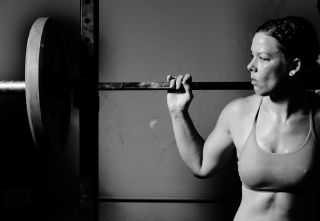Gender
Is CrossFit a Feminist Issue?
‘Strong is the New Beautiful’ for Crossfitters
Posted June 19, 2015
CrossFit divides the fitness folks. There are the passionate CrossFitters whose lives its practice has transformed and the ardent skeptics who cannot understand its attraction.
For example, New York Times reporter Heather Havrilesky stares at two women, urged on by their trainer, slamming a tire with sledgehammers in a parking lot outside of a fitness center. What inspires these women, she ponders, to engage in a ‘strange spectacle’ that to her appears to be fruitless, but quite dangerous body work? There are over 800 reader responses to Havrilesky’s curiosity, many defending CrossFit.
There are several exercise programs under the umbrella term of high-intensity interval training (HIIT) like Havrilesky describes above, but one of the most commercially successful is CrossFit (more than 7,000 affiliated gyms), a physical training regime that Heywood (2015a) characterizes as “both a training methodology and a competitive sport” (p. 21). ACEProSource magazine estimates that in 2013 there were about 10 million CrossFitters of whom 60% were women.
CrossFit was created by Greg Glassman and Lauren Jenai in 2000, but currently seems to be most visibly led by Glassman. Although CrossFit has thousands of affiliated gyms (‘boxes’), it also operates effectively through an Internet webpage featuring, for example, the workout of the day (WOD), articles of interest, CrossFitter news, and a monthly newsletter. In their July 2010 newsletter, Glassman concisely details the main characteristics of CrossFit.
According to Glassman, the aim of CrossFit is to prepare its practitioners for any physical contingency by engaging in broad, general, and inclusive fitness. CrossFit practice, characterized as ‘the sport of fitness,’ includes constantly varied, high intensity, functional movement. The workouts are performed in groups that provide support but also a competitive environment resembling sport participation. “Harnessing the natural camaraderie, competition, and fun of sport or games” Glassman believes, “yields an intensity that cannot be matched by other means” (p. 5). To further “motivate unprecedented output” and heighten the competitive spirit, the workouts are timed and the results are scored on whiteboards. As Glassman observes: “men will die for points” (p. 5).
The claims for CrossFit’s effectiveness have also interested scientists who have empirically tested its fitness claims.
John Porcari and his team conclude, simply that “CrossFit works” (AceProSource November, 2013, p. 4). They tested 16 volunteers (aged 20-60) doing two Workouts of the Day (WOD), the ‘Donkey Kong’ (burpees, kettlebell swings and box jumps) and ‘Fran’ (a front squat into a push press with a barbell). Participants’ heart rate (HR), VO2 max, lactate level, and Rate of Perceived Exertion (RPE) were measured after they performed each WOD three times with the number of repetitions decreasing (21 times, 15 times, and 9 times). Based on the participants’ heart rates (about 90% of their maximum) and their VO2 Max (about 80%) they worked at very high intensity which also resulted in very high lactate levels (usually linked with significant muscle soreness). While the workout burned “a fair number of calories,” “females burned significantly less calories…although they completed the workouts (in average workout 1 in 9.08min and 1 in 5.52min) almost at the same time as the men” (p. 3). The researchers noted that an exerciser can gain aerobic fitness and burn calories while spending less time, but warn that “the competitive nature and emphasis on completing CrossFit exercises as quickly as possible may well be a recipe for injury for some exercisers” (p. 4).
The participants in this research rated exercises ‘hard’ and the researchers also made a point to indicate that “workouts seemed very difficult for most of the subjects.” Smith, Sommer, Starkoff, and Devor (2013), who also recorded “meaningful” improvements of maximal aerobic capacity and body composition in the 23 men and 20 women who participated in their study, realized that 9 subjects (16% of the sample) did not complete the CrossFit program due to overuse or injury. Weisenthal and others (2014) recorded that about 20% of CrossFitters in their study were injured. Males were more likely to get injuries than females who, the researchers anticipated, sought more instruction from the coaches whose presence tended to lower the injury rate.
Based on these results, women CrossFitters gain significant aerobic fitness levels while getting less injured than men. Even if they are likely to consume less calories than men, the energy expenditure is still significant for a workout of a short duration. In addition, women can build a more muscular body in CrossFit workouts.
In the same July 2010 CrossFit newsletter, where Glassman summarizes CrossFit’s principles, August Schmidt discusses “why women need weight training.” He first acknowledges women’s concerns about growing “bulky or masculine” if lifting weights or exercising at high intensities. Schmidt then reasons that historically, women survived because of their strength while “the idea of a fragile, sedentary woman is a recent development” (p. 3). Strength does not turn women into men, because “masculine characteristics are caused by androgenic hormones. Women are women and men are men” (p. 3). High-intensity strength training, Schmidt continues, provides women with multiple fitness benefits such as higher bone density, increased basal metabolism, more efficient circulatory and respiratory systems, improved muscular strength and fat burning. In addition, this type of exercise relieves stress and develops mental toughness. Only “weak men,” he concludes, “may be threatened by physically capable women” (p. 3) and after all, a muscular 400m runner looks fitter than a walker.
So far, CrossFit appears to be an efficient way to improve physical fitness within a supportive group environment.
Some feminist researchers have specifically noted the egalitarian nature of CrossFit: women and men CrossFitters do the same workouts and exercise together in the same space often competing against each other (Heywood, 2015a, b; Knapp, 2014). In addition, it is estimated that 50-60% of the participants are women (Knapp, 2014). From a liberal feminist perspective—that advocates equal access and equal opportunity for women and men—Crossfit can be seen to advance feminist aims: women have access to the same spaces and workouts with men. Therefore, for many CrossFitter women, the ‘boxes’ provide environments where they can feel self-determined, strong, physically capable, competitive, and mentally tough similar to their fellow male exercisers.

Similar to Schmidt, Knapp (2014) and Heywood (2015b) observe that CrossFit advances a more muscular feminine body than the common extremely thin ideal. Many feminists find the thin ideal unrealistic for most women and note that a continual losing battle to obtain such an ideal leads to unhealthy obsessions, body related physical disorders (such as body dissatisfaction and body image distortion) and ultimately, eating disorders. Instead of aerobic training for weight loss, CrossFit type of power training requires using heavy loads that are moved fast. As a result, many CrossFitters believe that their bodies have become more muscular. Heywood (2015), for example, argues that CrossFit produces strong and toned feminine bodies that serve as inspirations for women to build more muscles. CrossFit, according to Heywood, initially rewrites “the beauty ideal by replacing it with strength – ‘strong is the new beautiful.’” As a result, women are able “to unlock the potential of their bodies” (p. 22).
The feminist researchers add, however, that sharing the same workouts with men or gaining a different body shape do not necessarily lead to women’s empowerment.
Knapp (2014), using a feminist cultural studies approach, is interested in seeing if CrossFit, despite its claims to the contrary, reproduces ideal femininity or ‘emphasized femininity.’ Emphasized femininity refers to a passive female body of “diminutive physical size and underdeveloped musculature” that is “thought to represent subservience and weakness” (p. 2) in comparison to powerful male bodies. To do this, Knapp analyzes photographs in all issues of the CrossFit Journal from 2002, 2006, 2008, and 2012.
She finds that although the ideal femininity was resisted, it was also reinforced in the Journal’s photographs. Only 28% of the pictures depicted women. This seems low considering the amount of women CrossFitters (about 50%). Women appeared in action far less than men (786 pictures of active women versus 2227 pictures of active men). Particularly in the later issues, women most often posed inactive (59%). She also notes that some articles reinforced the ideal femininity through dress (a woman lifting weights in a skirt or exercising in a bikini). Although less numerous, the depictions of women in weight lifting activities (weight training, gymnastics), however, were “transgressive through the development of musculature outside of the constraints of ideal femininity body norms” (p. 13). After the introduction of the CrossFit games, there was also an increase (33%) in pictures representing women. These later issues also showed “females engaging in activities that required higher levels of physicality” (p. 14) prompting Knapp to conclude that “although the numbers are not equal…gender inclusivity” in CrossFit Journal continues to increase (p. 14).
Heywood (2015b) concludes, more pessimistically, that despite the promise of a gender egalitarian space, CrossFit “undermines women’s ‘fulfillment’ through its enthusiastic participation in neoliberal dictates.” As a relatively costly exercise program, CrossFit is not accessible to all women. According to Heywood, CrossFit engages its participants, men and women, in never ending ‘self-production’ which success is measured in relation to extrinsic values, not intrinsic sense. Heywood finds that although CrossFit provides women with a safe environment to become strong, present, and self-determined, it also does so because social safety nets have disappeared in a neo-liberal society.
CrossFit obviously provides an outlet for many women to engage, together with men, in demanding high intensity workouts. They are not designed to improve everyday functionality of, for example, an office worker, teacher, nurse, or parent, but emphasize preparation for unknow/able physical contingency. Even if not necessarily anticipating such events, women can build more muscular bodies in CrossFit. The changed body shape appears one of its main attractions. In their responses to Havrilesky, many exercisers, men and women, emphasized the importance of building a better body in CrossFit.
Is CrossFit a Feminist Issue? Because CrossFit creates an egalitarian space to engage in high intensity physical activity and thus, like many reader comments indicated, it should be a good thing. However, its high intensity workouts are designed for a very specific purpose and are not, despite their claims for inclusivity, necessarily preferred by or suitable for everyone. CrossFit, like many other women’s exercise forms, can turn into a workout for building an ideal, toned (and thin) body shape. In this sense, it does not necessarily transform women’s fitness simply by being a ‘hard workout.’ Many less injury prone workouts target improving everyday functionality (posture, core strength, flexibility, muscle endurance, cardio-vascular fitness) more openly than CrossFit that aims for preparedness for physical contingency, not everyday living. Although CrossFit is not a guarantee of a better world for women, it can definitely provide a physical challenge for those looking to do a high intensity workout in a short time. Why women have only a short time to workout, of course, is a discussion for another time.
Works Cited:
AceProSource November, 2013, pp. 2-4.
Glassman, G. (2010, July). Understanding CrossFit. East Valley CrossFit Newsletter, Issue 1, p. 1, 5.
Havrilesky, H. (2014, October 14). The New York Times Magazine.
Heywood, L. (2015a). The CrossFit sensorium: Visuality, affect and immersive sport. Paragraph 38.1 (2015): 20–36
Heywood, L. (2015b). Strange borrowing: Affective neuroscience, neo-liberalism and the ‘cruelly optimistic’ gendered bodies of CrossFit. In C. Nally & A. Smith (Eds). Twenty-first century feminism: Forming and performing femininity (pp. 17-27). Basingstoke, UK: Plagrave/MacMillan.n Nally & Smith (Eds). 20th century feminism
Knapp, B. A. (2014): Gender representation in the CrossFit Journal: A content analysis. Sport in Society: Cultures, Commerce, Media, Politics, DOI: 10.1080/17430437.2014.982544.
Schmidt, A. (2010, July). Why women need strength training. East Valley CrossFit Newsletter, Issue 1, p. 3.
Smith, M. M., Sommer, A. J., Strakoff, B. E., & D. S. T. (2013). Crossfit-based high-intensity power training improves maximal aerobic fitness and body composition. Journal of Strength and Conditioning Research, 27(11): 3159-3172.
Weisenthal, B. M., Beck, C. A., Maloney, M. D., DeHaven, K. E., & Giordano, B. D. (2014). Injury rate and patterns among CrossFit athletes. The Orthopaedic Journal of Sports Medicine, 2(4), DOI: 10.1177/2325967114531177




